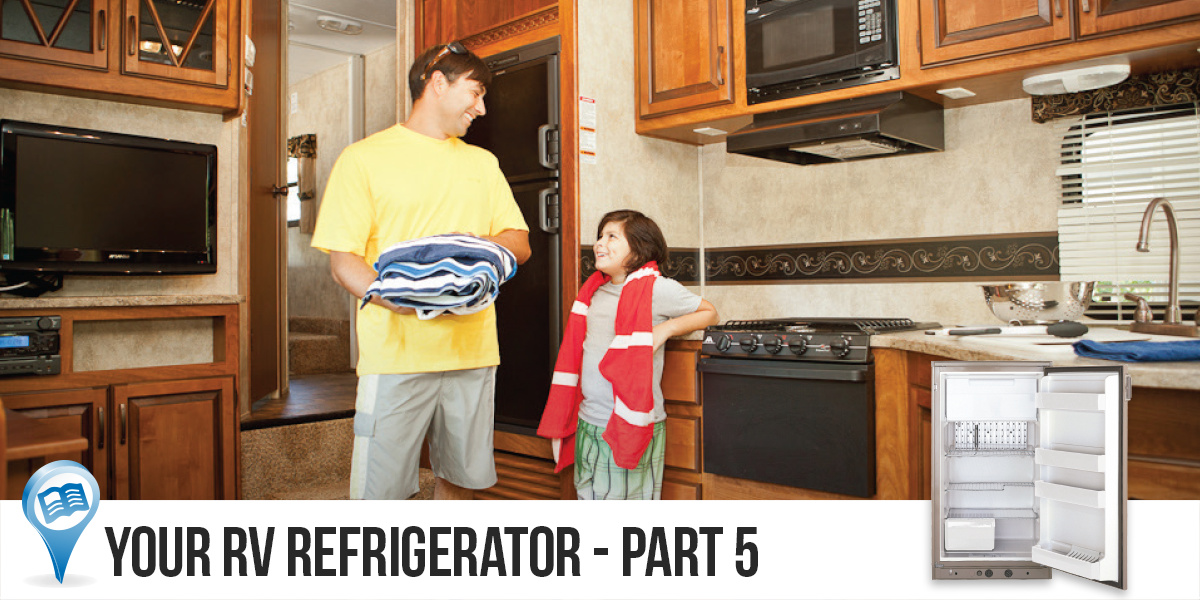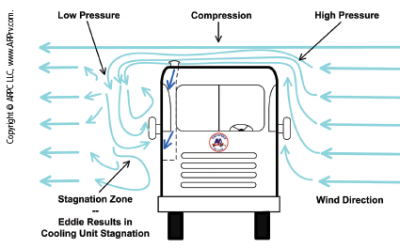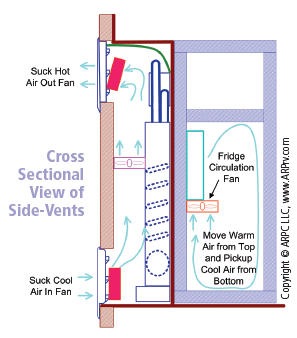
By Paul Unmack, PE-CSE, ME #116483, www.arprv.com
The first series of RV refrigeration articles discussed how the refrigeration process works and the control of the process. This article will explain why it is important to remove the heat from your refrigerator and as you prepare for an outing.
Heat and Your Refrigerator
As I covered in previous articles, heat drives the entire refrigeration process. In addition, heat has to be transferred from inside your refrigerator to the surrounding environment in order to keep the interior cool. So what happens if your refrigerator cannot rid itself of the generated heat? The simple answer is that it will not cool and the heat can heat up in your RV interior. You may even have noticed heat buildup in the cabinet area above your refrigerator. This is great if you want a toaster above your refrigerator, but most folks would rather not have the added heat in their RV.
Installation and Insulation
When the manufacturer builds an RV, the refrigerator should be insulated so that the heat produced at the back of the refrigerator has an exit to the exterior. Often there is no insulation at the top of the refrigerator, which produces a pocket where heat can collect. This pocket of heat can transfer heat to other areas, as well as into the interior of the refrigerator itself. An easy fix to this problem is to pack fiberglass insulation around the sides and top of the refrigerator between the refrigerator cabinet and the surrounding structure, preventing heat transfer. Once you insulate, put a cover over any loose insulation that may fall down and block the cooling unit air flow. As a word of caution, if insulation blocks the air flow in the cooling-unit compartment, the refrigerator will overheat.
RV Refrigerator Ventilation
Now that we have addressed insulating the refrigerator inside its cabinet, we can talk about the two types of cooling-unit venting.
 Roof Vent
Roof Vent
The traditional method used for ventilation is a side vent access door at the bottom of the refrigerator and a roof vent at the top (see illustration). This is the best configuration because it allows cool air to be pulled in from the side by air rising up through the cooling unit compartment. The air picks up heat and then exits out the roof vent.
There are two advantages to having the roof vent. One is that a draft is created by what is called the “chimney” or “stack” effect. The second advantage is that the heat is carried up, away from your RV, resulting in a much cooler interior. Roof vent type installations use natural convection, which means that fans are often unnecessary for assisting with ventilation.
Side Vent
The side vent method is becoming popular with the manufacturers (see illustration). This type of installation will have two vents on the side of the RV. Some side vent applications are for RVs with slide-outs where roof vents cannot be used. Other manufacturers are adopting side vent refrigerator installations to cut cost and create additional space by avoiding roof penetration that requires sealant to prevent water leaks. As opposed to the roof vent, the side vent reduces the chimney effect that helps carry the heat away. In some cases, wind can stop the convection entirely. As a result, the refrigerators with the side vents tend to fail more often than those with roof vents. The good news is that there are ways to improve venting for either type of vent installation.
Wind and Ventilation
The wind affects the ventilation of your refrigerator, sometimes in a positive manner and at other times in a negative way.
If the wind is blowing in the correct direction, it can force air into the lower side vent, pushing air out the top. The negative issue is when the wind blows past your RV, it can create “eddies” that result in low pressure and stagnation zones for the cooling air (see illustration). The result is that the cooling unit cannot reject its heat, which, in turn, slows down or even stops the refrigeration process. Side vents are more vulnerable to wind stagnation than roof vent applications. I believe this is a contributing factor to why folks with side vent refrigerators tend to have more problems. Our slide-in camper has a roof vent, but the refrigerator is mounted in a manner that results in over-heating when the wind blows.
ARP Control
Ventilation is key to the efficiency of your refrigerator. If it cannot expel its heat, the ammonia in the system remains as a vapor and does not return to the boiler of the cooling unit (discussed in a previous article). As a result, the boiler overheats and stops the fluids within the cooling unit from circulating. The ARP control detects this situation and intervenes by turning off the cooling unit heat source and only restarting the refrigerator when it is safe to do so.
Additional Cooling Fans
As the size of the RV refrigerators increased, manufacturers began installing fans as a standard item. The fans help, but they are mounted in a manner that tends to promote recirculation of the air within the cooling unit compartment. The reason for the recirculation is that the fans are mounted between the vents rather than at the vents. In addition, the method for controlling the fans is a mechanical snap switch that has a tendency to fail.
As a result of the above conditions, ARP control designed a precision fan controller that only turns on the fans when needed. Rather than a mechanical snap switch to activate the fans, the ARP fan control uses a temperature sensor. The temperature at which the fan turns on can be adjusted within a range of 90°F to 140°F. We provide blower-type fans that are quiet, move a lot of air and mount at the vent where they can suck in cool air, which forces out the hot air. For side vent applications, we recommend mounting a second fan to suck out the hot air that accumulates at the top of the refrigerator compartment. A further benefit of mounting a blower at the top vent is that it will push the hot air from the refrigerator away from the RV, keeping the slide-out and RV interior cooler.
Another method to increase efficiency is to mount 12V computer-type CPU fans inside the refrigerator. Mount the fans so they can blow on the cooling fins and circulate the air inside the refrigerator. With this method, there are a number of benefits. One is that the temperature is more uniform within the refrigerator, so that the cooling unit runs for less time. Another benefit is that frost will not build up as fast on the cooling fins. It is not necessary for the fans to run all the time. They need only run when the cooling unit is operating. By wiring the fans inside the refrigerator to the ARP fan controller, the fans will only run when they are needed.
Preparing For a Trip
Often I am asked how one should prepare for a road trip if the refrigerator has been off. It is stated that one should start the refrigerator a day before the trip, but I am an engineer and thus I am all about efficiency. Yes, the absorption refrigeration process takes a long time to initiate if there is nothing in the refrigerator and the refrigerator is warm. Because we do not like eating out too much, Mao and I will cook food and freeze it in our household refrigerator for our first week on the road. I will start the RV refrigerator a few hours before we leave, or the night before if we are leaving early in the morning, and place the frozen enchiladas and other goodies in the refrigerator to thaw out. By placing frozen food in the refrigerated space, the refrigerator drops in temperature within an hour or so. We receive the benefit of starting with a full LP tank and a cold beverage and enchiladas the first night out on the road.
Paul and Mao Unmack are mechanical engineers. Paul ran an automotive repair business in Red Lodge, Montana, for 20 years before receiving his engineering degree. He has practiced nuclear, fire suppression and industrial process control systems design. Mao designed pressure vessels for ammonia plants in China for 12 years, then came to the U.S. to get a master’s of welding engineering. She designed biodiesel plants and worked for a government-funded research and development organization. Paul and Mao run the entire ARP control business while taking on engineering consulting gigs. www.arprv.com












